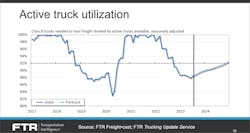Rate relief? Not for reefer carriers—or shippers
Refrigerated carriers won’t see much relief on rates in 2024—but neither will their shipping counterparts, according to a recent analysis by FTR Intel.
Spot and contract truckload rates in the reefer and dry van segments likely are at or near the bottom, reported Avery Vise, FTR vice president of trucking, but the excess capacity created in the post-pandemic spot-rate high remains, and operating costs are rising rapidly, restricting any year-over-year increases in the first half of the year.
Overall truckload, reefer, and dry van freight rates finally will start to tick up in the second half of 2024, Vise predicted.
“We see a pretty lackluster environment, one that’s probably not all that welcome for shippers—because shippers always want more cost relief—but also isn’t particularly welcome for carriers, who in a lot of cases are probably hoping a rising tide will bring them back … [if] a lot more capacity would exit the system,” Vise said Tuesday, Oct. 17, during FTR’s Q4 2023 Food Industry Economic & Transportation Update, presented with the Food Shippers of America and moderated by Paul Newbourne, FSA executive director.
See also: Foodservice distributors prep for Industry 4.0
The webinar included a high-level overview of the current economy, insights into evolving food consumption and distribution trends, and trucking-specific factors and expectations in the refrigerated and dry van food segments; along with similar analysis of the rail and intermodal industries by Eric Starks, FTR chairman.
‘Stable’ economy
Consumer spending has remained elevated, Vise asserted, with deflation-adjusted spending on goods similar to its peak in 2021, helping prop up a sluggish U.S. economy, and FTR forecasts that will continue into next year, despite “issues” like lower personal savings rates and rising consumer prices and financing costs.
“Our outlook for the economy is stable—but not really gangbusters,” Vise said. “We are looking at growth that is definitely below the long-term trend, pretty much into the middle of next year, [and] by the time we get to the end of next year, it’s still not exactly robust.
“The bigger takeaway is we’re not, at this point, forecasting any negative year-over-year [movement].”
Grocery store prices have “greatly normalized” since 2022, but the rising cost of eating at home helped food-service (restaurant) spending recover this year, contributing to consumption stability. And while consumer patterns are changing, with e-commerce orders, food delivery, and curbside pickup all growing, distribution channels remain relatively undisturbed, limiting the impact on shippers and carriers.
Additionally, food and beverage store inventories are improved, and a “solid” job market is canceling out consumption headwinds, Vise said.
No rate ‘runup’
Refrigerated freight rates are following a “more or less” seasonal pattern, albeit weakly, but are mired at the lowest level since 2019—and going nowhere fast, Vise contended. Reefer spot loads are down 100 loads per week since January—and 380 loads a week since their 2022 high—according to Truckstop data; and weekly broker-posted reefer spot rates are down 65 cents since January, and $1.45 from January 2022. “We will see within a few weeks whether we get any Thanksgiving bump,” Vise said. “We presume we will, but it remains to be seen.”
Still, refrigerated rates are up 20 cents from their Q2 low, and the broader truckload spot market is more “in sync” with the rest of the freight market, strengthening overall stability and lending optimism to FTR’s food transport forecast. “The year-over-year outlook for refrigerated looks pretty weak until we get to around the middle of next year, when we start to see some … fairly significant acceleration—getting close to 4% year-over-year growth by the time we get to the end of next year,” Vise said.
FTR’s total truckload spot rate outlook calls for modest 10% growth in the second half of 2024, with reefer and dry van following similar trends. “I would not expect a whole lot of further deflation, at least in spot rates,” Vise said. “[But] we’re not expecting to see a big runup in spot rates in any of these sectors, or in total.” The firm also expects “considerable” year-over-year strength in tank food loadings to continue, helping prop up contract freight, but not much. “The contract outlook is far more shallow,” Vise continued. “We do not believe we’ve necessarily bottomed out here, but we don’t expect a lot of change from this point on. We really expect it to be a very gradual bottoming out, in overall and refrigerated and dry van, but then also not a particularly strong recovery, at least not in 2024.
“We really only start to see year-over-year increases in the second half—and even by the end of the year, those increases are fairly small.”
Capacity crunch
The Yellow shutdown shocked the less-than-truckload driver pool, but truckload employment, which hit record highs in May, still is running at “a very high level,” Vise said, basing his analysis on Bureau of Labor Statistics data. “It is interesting that, despite the weak rate environment and the overall freight environment, we set a record in terms of the number of pre-employment inquiries [to the Federal Motor Carrier Association’s Drug & Alcohol Clearinghouse],” he said. And truckload payroll employment remains high despite the “largest decline ever” in the for-hire carrier population over the last four quarters, he added.
“We still are not reversing what was created [in the post-pandemic surge of new motor carrier approvals],” Vise said. “We still have had a substantial increase. We estimate roughly a 52% increase in the number of drivers associated with carriers with one to five trucks—but they are failing in very large numbers. And one of the reasons is it has become far less financially attractive to be a one-truck operation.”
To his point, weekly incomes for one-truck carriers have fallen “considerably” in reefer, dry van, and flatbed, with reefer income plummeting from over $2,500 per week in September 2021 to less than $1,000 per week in September 2023, according to multiple sources; while company driver income is steadily rising, helping larger carriers boost their workforces.
“We do believe that’s coming to an end—and one of the reasons is [truck] utilization,” Vise advised.
Active truck utilization, which is the seasonally adjusted number of Class 8 trucks needed to haul freight divided by active trucks available, is at 88% and expected to climb only slowly throughout 2024, according to FTR’s Freightcast.
Shipper-carrier relationship
One reason truck utilization is low is carriers want to hold onto their idle drivers, so they’re ready to capitalize when the freight market turns around. That’s why carriers and shippers should work together to bring stability to their relationships amid fluctuating capacity and rates, ensuring long-term success for both parties, Vise concluded.
See also: Electric reefers: The time to prepare is eNow
“The main thing that carriers are worried about right now is having enough volume,” he said. “They don’t want to lose their drivers. They worked very hard to get their drivers. That’s one reason why utilization right now is so weak. Purely from an economic standpoint, a lot of carriers would be better off if they cut their driver force and tightened things. But it also means the next time around they’re going to have to spend more money to get those drivers back.
“So, the best thing a shipper can do is work with a cadre of carriers in a way that gives them a realistic expectation of what their volumes are going to be.”
About the Author

Jason McDaniel
Jason McDaniel, based in the Houston TX area, has nearly 20 years of experience as a journalist. He spent 15 writing and editing for daily newspapers, including the Houston Chronicle, and began covering the commercial vehicle industry in 2018. He was named editor of Bulk Transporter and Refrigerated Transporter magazines in July 2020.



